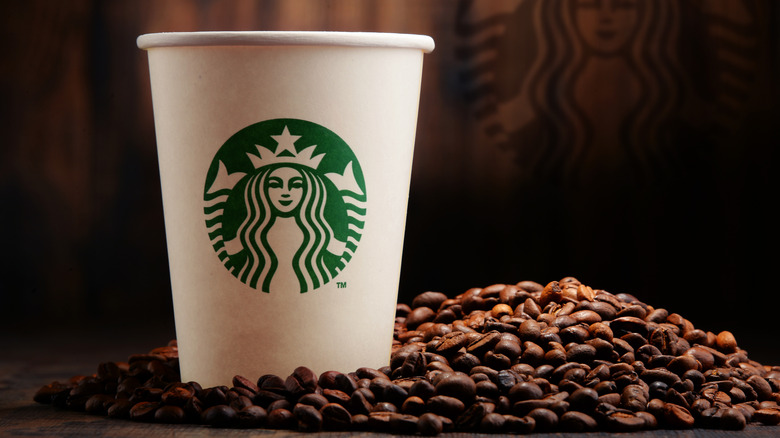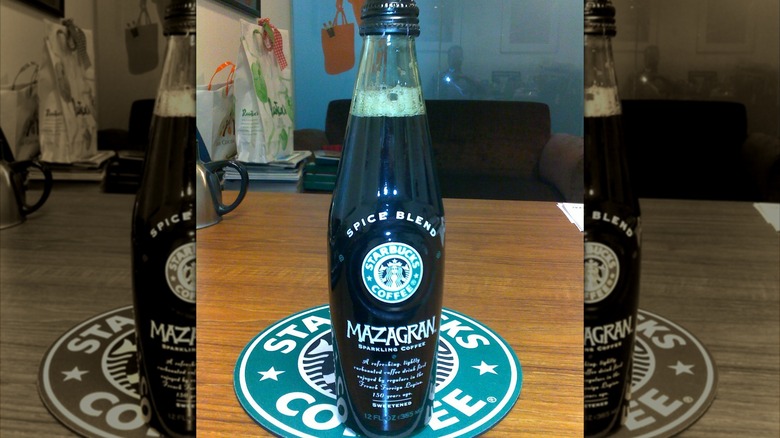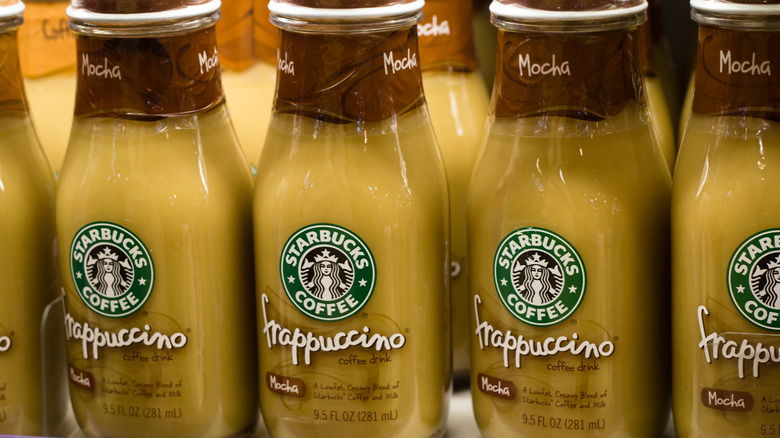The Discontinued Starbucks Bottled Drink That Was Fizzing With Controversy
Way back in 1994, America was a different place. Bill Clinton was president, AOL was delivered to homes via CDs in the mail, and Starbucks launched a product that no one recognized: It was called Mazagran, and it was a cold, carbonated, bottled coffee.
There's not much information about this failed attempt at bringing something new to the shelves of Starbucks, and that's perhaps unsurprising. It lasted for about a year before it was pulled and relegated to the darkest corners of corporate history, the shadowy place reserved for the bad ideas that everyone wants to forget. But Mazagran wasn't a total waste, and it ended up paving the way for one of the company's most popular products today. Although the product never caught on, and most consumers only tried it once, it is an important part of the brand's history.
That makes it a pretty interesting look at how — and why — some of the biggest companies in the world put out products that fail, and how they weather that failure to turn things around. There's an important lesson to be learned there: Failures are only failures if you don't move on from them.
Mazagran was inspired by a 19th century coffee and military victory
Howard Schultz is the entrepreneur who built the infamous company along the lines of Italy's coffee bars, and he wrote about the failure of Mazagran in a book (via Fox News). It was explained that when it hit shelves, "... it polarized people. Some loved it, others hated it. A lot of customers were willing to give it a try because of the Starbucks brand name, but Mazagran didn't get the repeat business we had hoped for. We finally realized, with disappointment, that we had created a niche product, one that would catch on, if at all, only after a slow build."
Mazagran was something of an abnormality in the coffee market: While iced coffee is common today, it wasn't back in 1994, leaving customers to shun the bubbling beverage. And let's talk about that name.
Schultz wrote that he took the name from a drink that had been popular in Algeria, and that's a fascinating story in itself. In 1840, 123 French soldiers found themselves trapped in a fortress besieged by Algerian forces. Unable to mix their coffee with their favored brandy, they ended up mixing it with water. Reinforcements ultimately came to their rescue, and before long, it became a trendy thing among the French to order their coffee in the same style. Sometimes it was served with cold water, sometimes with ice, and it was always named after the fortress: Mazagran.
Mazagran may have failed, but it opened to door for the bottled Frappuccino
Former CEO Howard Schultz wasn't alone in making Starbucks a success; some serious credit goes to the brand's longtime head of Research and Development, Don Valencia. Valencia first got Schultz's attention when he — a cell biologist by trade — created an extra flavorful dried powder from Starbucks beans. He started working for them in 1993, and his first product was Mazagran.
Sure, it was a flop, but it was a testament to Schultz's vision that instead of moving on to the next R&D head, they kept Valencia and instead pivoted to an adjacent product. In the creation of Mazagran, they developed a coffee extract that they used in another product: the bottled Frappuccino. When the Frappuccino went to market in 1996, it was a resounding success that's been going strong for years since.
In 2009, The Seattle Times did a small profile piece on Valencia and his contributions to Starbucks. They found that he had long kept a vanity license plate that read "MAZGRAN," as a reminder that one failure wasn't the end. Valencia passed away in 2007, and Starbucks paid tribute to him in the Via product line. So even though Mazagran wasn't the smash hit Starbucks was looking for, it certainly paved the way for many other successful beverages that customers love today.


